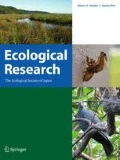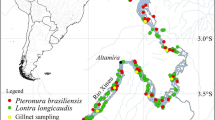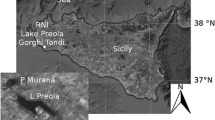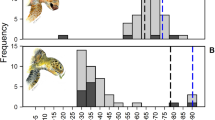Abstract
Freshwater turtles are threatened globally; however, short-necked turtles in Eastern Australia have been particularly successful in exploiting natural and man-made permanent water bodies. The catchments of eastern Australia offer a unique opportunity to compare the diets of species in habitats where both genera co-exist, but only one genus is usually locally dominant. We compared the diets of species of Emydura and Myuchelys and Flaviemys in inland and coastal catchments in eastern Australia to determine the breadth of diets. We also conducted a more in depth study of the ecology and habitat preferences of the Bellinger River Emydura (Emydura macquarii macquarii) and Myuchelys georgesi. We found that diets of short-necked turtles on the east coast of Australia are separated by water conditions, and largely independent of species and location. Species of Myuchelys and Emydura are omnivorous. A high proportion of their food is from benthic macro-invertebrate communities in clear water. Terrestrial invertebrates and filamentous algae are present more in the diets of species inhabiting turbid water. Competition between species of Emydura and Myuchelys/Flaviemys is likely to occur when in sympatry, because species of Emydura can adapt their diets to various habitats and water quality. Myuchelys georgesi is restricted to, but common in, the Bellinger River. Interspecific competition may occur between E. m. macquarii and M. georgesi because of similar habitat preferences, diets and life histories. Emydura m. macquarii is not unique to the Bellinger River and hybridization with the endemic M. georgesi is a threatening process.



Similar content being viewed by others
References
Allanson M, Georges A (1999) Diet of Elseya purvisi and Elseya georgesi (Testudinata: chelidae), a sibling species pair of freshwater turtles, from eastern Australia. Chelonian Conserv Biol 3:473–477
Bjorndal KA (1991) Diet mixing: nonadditive interactions of diet items in an omnivorous freshwater turtle. Ecology 72:1234–1241
Blamires SJ, Spencer R-J (2013) Influences of habitat and predation on population dynamics of the freshwater turtle Myuchelys georgesi. Herpetologica 69:46–57
Blamires SJ, Spencer RJ, King P, Thompson MB (2005) Population parameters and life-table analysis of two coexisting freshwater turtles: are the Bellinger River turtle populations threatened? Wildl Res 32(4):339–347. doi:10.1071/WR04083
Buhlmann KA, Akre TSB, Iverson JB, Karapatakis D, Mittermeier RA, Georges A, Rhodin AGJ, van Dijk PP, Gibbons JW (2009) A global analysis of tortoise and freshwater turtle distributions with identification of priority conservation areas. Chelon Conserv Biol 8:116–149
Burbidge AA (1981) The ecology of the western swamp tortoise Pseudemydura umbrina (Testudines: chelidae). Wildl Res 8:203–223. doi:10.1071/WR9810203
Cann J (1994) The Bellinger and Orara Rivers water supply scheme: an aquatic study of the freshwater turtles. In: McCotter M (ed) Supplementary document for the environmental impact statement for the raising of Karangi Dam. Report to the Coffs Harbour City Council and the Public Works Department, Coffs Harbour
Cann J (1998) Australian freshwater turtles. Beaumont Publishing, Singapore
Chessman BC (1986) Diet of the Murray turtle, Emydura macquarii (Gray) (Testudines: Chelidae). Wildl Res 13:65–69. doi:10.1071/WR9860065
Chessman BC (2011) Declines of freshwater turtles associated with climatic drying in Australia’s Murray–Darling Basin. Wildl Res 38:664–671. doi:10.1071/WR11108
Clarke KR, Green RH (1988) Statistical design and analysis for a” biological effects” study. Mar Ecol Prog Ser 46:213–226
Cole GA (1994) Textbook of Limnology, 4th edn. Waveland Press Inc, Prospect Heights
Congdon JD (1989) Proximate and evolutionary constraints on energy relations of reptiles. Physiol Zool 62:356–373
Congdon JD, Gibbons JW (1989) Biomass productivity of turtles in freshwater wetlands: a geographic comparison. In: Sharitz RR, Gibbons JW (eds) Freshwater Wetlands and Wildlife. CONF-8603101, United States Department of Energy Symposium Series No. 61, Office of Scientific and Technical Information, Oak Ridge, Tennessee, pp 583-592
Congdon JD, Gotte SW, McDiarmid RW (1992) Ontogenetic changes in habitat use by juvenile turtles, Chelydra serpentina and Chrysemys picta. Can Field-Nat 106:241–248
Corbett L (1995) The dingo in Australia and Asia. The University of New South Wales Press, Sydney
Fletcher AR, Morison AK, Hume DJ (1985) Effects of carp, Cyprinus carpio L., on communities of aquatic vegetation and turbidity of waterbodies in the lower Goulburn River basin. Aust J Mar Freshw Res 36(3):311–329. doi:10.1071/MF9850311
Georges A (1982) Diet of the Australian freshwater turtle Emydura krefftii (Chelonia: Chelidae), in an Unproductive Lentic Environment. Copeia 1982:331–336
Georges A, Thomson S (2010) Diversity of Australasian freshwater turtles, with an annotated synonymy and keys to species. Zootaxa 2496:1–37
Georges A, Norris RH, Wensing L (1986) Diet of the freshwater turtle, Chelodina longicollis (Testudines: Chelidae) from the coastal dune lakes of the Jervis Bay Territory. Wildl Res 13:301–308. doi:10.1071/WR9860301
Georges A, Spencer RJ, Welsh M, Shaffer HB, Walsh R, Zhang X (2011) Application of the precautionary principle to taxa of uncertain status: the case of the Bellinger River turtle. Endang Sp Res 14:127–134. doi:10.3354/esr00350
Le M, Reid BN, McCord WP, Naro-Maciel E, Raxworthy CJ, Amato G, Georges A (2013) Resolving the phylogenetic history of the short-necked turtles, genera Elseya and Myuchelys (Testudines: Chelidae) from Australia and New Guinea. Mol Phylogenet Evol 68:251–258. doi:10.1016/j.ympev.2013.03.023
Legendre P, Legendre L (1998) Numerical ecology, 2nd English edn. Elsevier, Amsterdam
Legler JM (1976) Feeding habits of some Australian short-necked tortoises. Victorian Nat 93:40–43
Legler JM (1977) Stomach flushing: a technique for chelonian dietary studies. Herpetologica 33:281–284
Legler JM (1978) Observations on behaviour and ecology in an Australian turtle, Chelodina expansa (Testudines: Chelidae). Can J Zool 56:2449–2453. doi:10.1139/z78-330
Legler JM, Cann J (1980) A new genus and species of chelid turtle from Queensland, Australia. Contrib Sci Natur Hist Mus Los Angeles County 324:1–18
Rowe JR, Coval KA, Campbell KC (2003) Reproductive characteristics of female Midland painted turtles (Chrysemys picta marginata) from a population on Beaver Island, Michigan. Copeia 2003:326–336
Seddon JM, Georges A, Baverstock PR, McCord W (1997) Phylogenetic relationships of chelid turtles (Pleurodira: Chelidae) based on mitochondrial 12S rRNA gene sequence variation. Mol Phylogenet Evol 7:55–61. doi:10.1006/mpev.1996.0372
Sexton OJ (1959) A method for estimating the age of painted turtles for use in demographic studies. Ecology 40:716–718
Souza FL, Abe AS (2000) Feeding ecology, density and biomass of the freshwater turtle, Phrynops geoffroanus, inhabiting a polluted urban river in south-eastern Brazil. J Zool 252:437–446. doi:10.1111/j.1469-7998.2000.tb01226.x
Spencer RJ (2002) Growth patterns of two widely distributed freshwater turtles and a comparison of common methods used to estimate age. Aust J Zool 50:477–490. doi:10.1071/ZO01066
Spencer RJ, Thompson MB (2005) Experimental analysis of the impact of foxes on freshwater turtle populations. Conserv Biol 19:845–854. doi:10.1111/j.1523-1739.2005.00487.x
Spencer RJ, Thompson MB, Hume ID (1998) The diet and digestive energetics of an Australian short-necked turtle, Emydura macquarii. Comp Biochem Physiol A 121:341–349. doi:10.1016/S1095-6433(98)10132-0
Spencer RJ, Janzen FJ, Thompson MB (2006) Counterintuitive density-dependent growth in a long-lived vertebrate after removal of nest predators. Ecology 87:3109–3118. doi:10.1890/0012-9658(2006)87[3109:CDGIAL]2.0.CO;2
Thompson MB (1982) A marking system for tortoises in use in South Australia. S Aust Nat 57:33–34
Williams WD (1980) An Ecological Basis for Water Resource Management. Australian National University Press, Canberra
Acknowledgments
This work was funded by an ARC Linkage Grant and by the National Parks and Wildlife Service and Bellingen Landcare Group through the Fox Threat Abatement Plan. Surveys were conducted under QPWS and NSW National Parks and Wildlife Service Permits (B1313), University of Canberra and University of Sydney Animal Care and Ethic Committee approval (ACEC # L04/12-94/2/2017) and NSW Fisheries License number F86/2050. We thank C. Limpus (QPWS) and S.Hull (NPWS) assisted in finding sites and fieldwork. We also thank M. Welsh, M. Page, S. Blamires, B. Nesbitt, D. Booth, F. Seebacher, P. King, T. Scanlon, A. Harber, T. Prior, and local volunteers for their help with field work. We thank A. Hickey, J. and N. Ralph, D. Browning, L. Lemke, P. Kinmon, S. Eyre, J. Kramer, P. Krug, Dreamtime, Kandahar, and Homelands Communities, and Orama Public School for access to the Bellinger River.
Author information
Authors and Affiliations
Corresponding author
About this article
Cite this article
Spencer, RJ., Georges, A., Lim, D. et al. The risk of inter-specific competition in Australian short-necked turtles. Ecol Res 29, 767–777 (2014). https://doi.org/10.1007/s11284-014-1169-7
Received:
Accepted:
Published:
Issue Date:
DOI: https://doi.org/10.1007/s11284-014-1169-7




